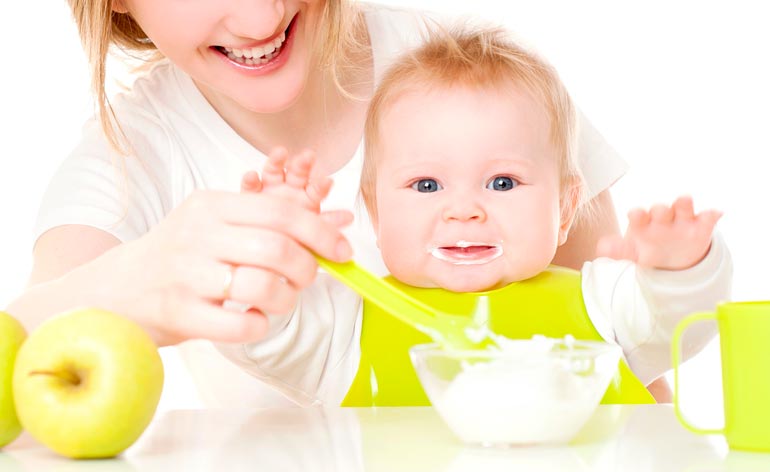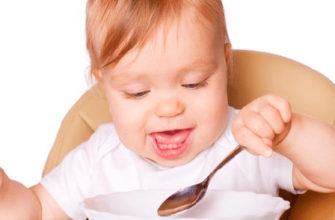Parents of young children always want to feed them something tasty and healthy. It is for this reason that the question of introducing complementary foods arises in them already at 3-4 months of a child's life. But is it worth it in a hurry? Maybe it’s better to wait a bit and allow yourself to enjoy a time when you do not need to constantly sterilize bottles, cook mixtures and cereals, for fear of possible poor quality products? A day will come when you can see for yourself that your little baby needs additional food and is ready for it. 10 signs will help you determine this.

Signs of baby's readiness for feeding
The development of children of the same age is not always the same. From some, the baby learned to hold the head at 3 months, while from others the baby knew how to do it already at 2 months. Each child has its own peculiarities of the organism, its own character and its own pace of development. It depends not only on hereditary factors - the course of pregnancy, childbirth, as well as caring for the baby, have an effect here. Therefore, it is impossible to determine the age of a child who is ready for feeding in specific numbers.
Specialists attach importance to only two factors that testify to the child’s readiness to accept new food for him:
- Ripening of the nervous system and brain of a child.
- Gastrointestinal tract (GIT) readiness of the baby.
When both factors coincide in time, we can say that the baby is ready for feeding. To verify the presence of these factors will help the following signs:
- Baby age. After the child is 4 months old. The same applies to premature babies, with only one amendment - their readiness is calculated on the basis of gestational age. This means that if a baby born in due time begins to receive complementary foods after 17 weeks, a premature baby born 4 weeks earlier can receive complementary foods only 21 weeks after birth;
- Weight. Since the birth of the baby, his weight has increased 2 times. If the baby is premature - its weight should exceed birth weight 2.5 times;
- Tongue push reflex. So that a child can take food from a spoon, he should not make reflexive pushing out movements with his tongue, which are innate and protect the baby from falling into the mouth of random objects. If reflex movements are still present during the test, then feeding is still too early. To check for this factor, give your baby a drink from a spoon. If water does not appear on the chin - the child is ready for feeding. This is an important point, since with the introduction of complementary foods, food should be given from a spoon so that the food is processed by the baby's saliva and is easier to digest in his stomach;
- Ability to sit. The child should sit well and hold the head.If the baby does not sit well and cannot confidently control the movements of the head, so that at the right time to move away or turn away, refusing to eat, it is still too early to feed. The baby can demonstrate a rejection of food and unwillingness to eat;
- Lack of main power. If the baby completely sucks all the milk from two breasts in one feeding and remains hungry, and the “artificer” baby does not eat up one liter of the mixture during the day, then complementary foods are necessary (also if the interval between meals begins to decrease);
- The kid is all drawn to his mouth, even inedible objects;
- The child must be able to pull forward the lower lipto take food from a spoon and be able to move the tongue up and down and back and forth. The baby opens her mouth when they bring a spoon with food;
- The child is able to grab lumps of food with his tongue and push them deep into the mouth.The child mastered the skills of chewing;
- The appearance of the first teeth;
- Expression of interest in the food of parents and attempts to try it to your taste. A baby who watches how you eat and makes an attempt to steal a piece from you is usually ready to start feeding.
However, one should not expect an indispensable manifestation of all the above signs in order to begin to introduce complementary foods to the baby. It will be sufficient to have most of the above signs. A preliminary consultation with a pediatrician should be mandatory - only a doctor will be able to confirm that your baby is ready for new food and correctly paint his future menu.
Memo to parents:
- You can introduce complementary foods only when the child is absolutely healthy.
- Complementary feeding is recommended during the second feeding.
- Any food for the baby should be warm and should be given before the main breastfeeding or infant formula.
- Feed the baby only with a spoon. If you are giving baby puree vegetables for the first time, you can mix it with milk and feed the baby from the bottle. This will facilitate the child’s addiction to new products and taste sensations (read also: how to teach a child to eat with a spoon - 10 simple tips).
- Any new porridge or mashed potatoes should first be given to the baby a quarter of a spoon, increasing the amount of complementary foods to the appropriate portion for two weeks.
- It is advisable to make the first lure from mashed vegetables and fruits typical of your region. For an African baby, the first lure from banana puree will be most preferable, while for a baby from Russia, an absolutely identical puree can cause poor health and digestive upset.
- Do not give the crumbs a new product until it gets used to the old one. After the baby has tried some new dish, the following is recommended to be introduced after 2 weeks.
- The first lure - only in the form of mashed potatoes and only from one type of fruit or vegetables. So you can find out, if necessary, which product your child is allergic to.
- Mashed potatoes at the beginning of the introduction of complementary foods should be liquid and resemble thick milk in their consistency. Each time, the amount of liquid must be reduced, bringing the appearance of the puree closer to its natural density.
- If you decide to give your baby ready-made baby food, pay attention to two points. The first is the date of manufacture. Everything should be as fresh as possible, otherwise the child may be poisoned. The second point is the composition. To exclude the possibility of an allergic reaction and indigestion, salts, sucrose, sugar, dextrose should not be present in the selected product.
When should the first lure be postponed for one to two weeks?
- The child is sick;
- Teeth are actively being cut, the baby is naughty, crying, and fever;
- A family with a baby travels, often moves from place to place, recently changed his place of residence;
- The baby gets used to the changes in family life: mother went to work, a nanny appeared in the house;
- The first tests of complementary foods gave a negative reaction (there was diarrhea, rashes on the skin, etc.);
- A vaccination was given.
On the topic of complementary foods:
- When and where to start the first lure, how to introduce new products: the basics, tips and rules
- Feeding a baby on artificial feeding
- The beginning of feeding children on hepatitis B
- What to do if the child refuses to feed (does not eat porridge), and does not want to eat from a spoon
So, to summarize:
When in time two factors coincide:
- There are no problems with the gastrointestinal tract, allergic reactions, when the child begins to try new food.
- The kid does everything himself: takes food by hand, delivers it to the mouth, swallows or spits out if the food does not like.
THE CHILD IS READY TO FEED!
10 reasons to introduce complementary foods









As a young mother (I am now 42 years old), I knew that I should be feeding from six months. Then I was only 19 years old. We fed the child “domestic” fruits (so as not to cause allergies), cereals, mashed potatoes and vegetable soups. Only in 2 years the period of our complementary feeding ended, the child switched to regular food. There was little difficulty with complementary foods; the youngest son refused vegetable soups during complementary foods. In general, we can say that the stage of complementary feeding is very important for the child, because it is at this age that the child should receive a sufficient amount of nutrients for normal further development.
About 4 months later, I realized that it was time to introduce spice when my baby’s weight stopped increasing, and it became clear that he was not enough breast milk. Vegetable and fruit purees gradually began to enter our diet. After going to the pediatrician and weighing weight returned to normal.
It seems to me that you need to look at a particular child, whether he is ready for the introduction of complementary foods. So, for example, we started at 7 months. homemade sour milk. I know that many start with cereals or vegetables. But we had some digestive problems, so I started to give “yogurt”, which I cook with Bifidum sourdough from Bakzdrav. It contains a lot of bifidobacteria and lactobacilli, which are necessary for proper digestion. They populate the microflora of the baby, as well as bacteria coming from mother's milk. And for the artificers, it seems to me that there are no options - you need to start complementary foods with sour milk.